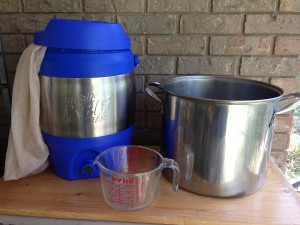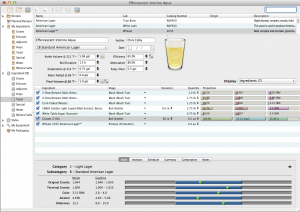It’s summer. It can get hot as hell at times, especially after some yard work or exercising. Even the most dedicated homebrewer or craft beer aficionado can occasionally appreciate a “fizzy yellow lager” — or the ale equivalent — under these circumstances. They’re crisp, they’re light, they’re effervescent — and sometimes, they’re just the thing to slake your thirst. If you’d like to brew a cream ale or American Pilsner style beer, here’s a countertop partial mash recipe for 5.0 gallons (19 L) that will show you how. (And if you’re an unbearable craft beer purist who is absolutely compelled to turn up his nose at this style of beer, go check out my series on Russian imperial stouts.)
The biggest keys to success here are using the freshest possible ingredients, not scorching the extract, and running a good fermentation. If you use old liquid malt extract, the color of your beer will be too dark, and you’ll probably taste a little oxidation. You’ll add more unwanted color to the beer of you scorch the malt extract. (So, dissolve it in wort first.) Running a good fermentation will keep the beer crisp and free from excessive yeast-derived aromas (esp. esters, which you want to minimize in this type of beer). If you’re brewing the lager version, consider kräusening it.
And finally, if you want to brew this in the traditional manner, brew the beer initially as a fairly strong beer (around OG 1.064), then dilute it to working strength with deaerated water in the keg. (The recipe gives the straightforward method of brewing the beer — no kräusening or high-gravity brewing. But those techniques aren’t too hard to add, if you’d like.)
If you’ve never brewed a beer using a countertop partial mash before, review the technique before you start. You’ll need a 2-gallon beverage cooler with a spigot, and a large steeping bag in addition to your usual extract brewing equipment.
Effervescent Icterine Aqua
(AKA Fizzy Yellow Water)
Cream Ale (or American Pilsner)
by Chris Colby
Extract; English units
DESCRIPTION
A light, dry, fizzy beer for summer consumption. Can be made as a cream ale or American Pilsner.
INGREDIENTS (for 5 gallons)
Water
For partial mash:
adjust brewing liquor so that mash falls into pH range of 5.2–5.4 (or use 2 gallons of distilled water with 0.25 tsp. gypsum and 0.25 tsp. calcium chloride added)
For remaining water:
carbon-filtered tap water
Malts and Adjunct (for an OG of 1.046 and 5 SRM)
1.0. lb. 12 oz. US 6-row pale malt or brewers malt
1.0. lb. US 2-row pale malt or brewers malt
1.0 lb. 4 oz. flaked maize
2.75 lb. light or extra light liquid malt extract (fresh)
12 oz. cane sugar
Hops (13 IBU total)
Cluster hops (13 IBU)
0.5 oz., at 7% alpha acids, boiled for 60 mins
Yeast (for an FG of 1.009 and 4.8% ABV)
Wyeast 1056 (American Ale) or White Labs WLP001 (California Ale) yeast — for cream ale
(2-qt. yeast starter)
or
Wyeast 2035 (American Lager) yeast, or any lager yeast — for American Pilsner
(4-qt. yeast starter)
Other
0.50 tsp. Irish moss
0.50 tsp yeast nutrients
Optional: 8 g (~3 tsp.) Polyclar AT (PVPP)
5.25 oz. corn sugar (for priming to 2.6 volumes of CO2) — for cream ale
4.75 oz. corn sugar (for priming to 2.6 volumes of CO2) — for American Pilsener
PROCEDURES
Make your yeast starter, around OG 1.020, 2–3 days ahead of brewday. Aerate the starter wort well and ferment at room temperature (even if you’re making the lager). On brewday, heat 5.5 qts. of brewing liquor to 161 °F in your brewpot. Place the crushed grains and flaked maize in a large steeping bag, dunk the grain bag in your brewpot, and mash grains at 149 °F for 60 minutes. Stir frequently and add heat in short bursts, when needed, to maintain the temperature. While grains are mashing, heat 2.5 gallons of sparge water to 170 °F. When the mash is over, heat it — stirring constantly — to 170 °F. Lift the grain bag out of brewpot and let it drip, then transfer it to your 2-gallon cooler. Gently scoop or pour the wort from your brewpot into the cooler. (Go slowly if pouring.) Rinse out the brewpot. Recirculate the wort for 20 minutes, or until it clears significantly, whichever comes first. Do this by running off 2 cups of wort and pouring it gently back on top of the grain bed. After 30 seconds, repeat. Collect around 3.5 gallons of wort by first running off 2 cups of wort and pouring it into your brewpot. Then, gently add 2 cups of 170 °F sparge water to top of grain bed. Wait about 30 seconds to 1 minute then repeat. Keep repeating until you collect 2.75 gallons of wort. Add water to make approximately 3.5 gallons of wort total. Boil the wort to a hard boil. If hot break does not appear as big, fluffy flakes after the first 5 minutes of boiling, add 0.25 tsp. of calcium chloride. Once hot break appears, add hops and boil for 60 minutes. Do not let boil volume dip below 3.0 gallons. Add boiling water to top up, if necessary. Add Irish moss and yeast nutrients with 15 minutes left in the boil. Stir in the liquid malt extract and sugar at knockout. Dissolve the extract in wort to make it easier to stir in and avoid scorching. Chill wort to 66 °F (50 °F for American Pilsner) and transfer to fermenter. Add cool water to make 5.0 gallons of wort. Aerate the wort thoroughly and pitch sediment from yeast starter. Ferment at 68 °F — or 52 °F if using the lager yeast strain. When lager fermentation slows greatly, allow temperature to rise to 60 °F for 2–3 days for a diacetyl rest. After fermentation has been complete for 2–3 days, rack to secondary and move the fermenter to a cool location (below fermentation temperature, but above freezing). Cold condition for 2 weeks (or lager for 6 weeks in case of American Pilsner). Bottle or keg and carbonate to 2.6 volumes of CO2.
Option (for Clearer Beer): After fermentation and conditioning, dissolve 8 g of PVPP in roughly 2 fl. oz. (60 mL) of hot water and gently stir into top layer of beer. Let settle overnight, then rack beer to keg or bottling bucket.
Effervescent Icterine Aqua
(AKA Fizzy Yellow Water)
Cream Ale (or American Pilsner)
by Chris Colby
Extract; metric units
INGREDIENTS (for 19 L)
Water
For partial mash:
adjust brewing liquor so that mash falls into pH range of 5.2–5.4 (or use 2 gallons of distilled water with 0.25 tsp. gypsum and 0.25 tsp. calcium chloride added)
For remaining water:
carbon-filtered tap water
Malts and Adjunct (for an OG of 1.046 and 5 SRM)
790 g US 6-row pale malt or brewers malt
450 g US 2-row pale malt or brewers malt
570 g flaked maize
1.25 kg light or extra light liquid malt extract (fresh)
340 g cane sugar
Hops (13 IBU total)
Cluster hops (13 IBU)
14 g, at 7% alpha acids, boiled for 60 mins
Yeast (for an FG of 1.009 and 4.8% ABV)
Wyeast 1056 (American Ale) or White Labs WLP001 (California Ale) yeast — for cream ale
(2-L yeast starter)
or
Wyeast 2035 (American Lager) yeast, or any lager yeast — for American Pilsner
(4-L yeast starter)
Other
0.50 tsp. Irish moss
0.50 tsp yeast nutrients
Optional: 8 g (~3 tsp.) Polyclar AT (PVPP)
150 g corn sugar (for priming to 2.6 volumes of CO2) — for cream ale
130 g corn sugar (for priming to 2.6 volumes of CO2) — for American Pilsener
PROCEDURES
Make your yeast starter, around OG 1.020, 2–3 days ahead of brewday. Aerate the starter wort well and ferment at room temperature (even if you’re making the lager). On brewday, heat 5.2 L of brewing liquor to 72 °C in your brewpot. Place the crushed grains and flaked maize in a large steeping bag, dunk the grain bag in your brewpot, and mash grains at 65 °C for 60 minutes. Stir frequently and add heat in short bursts, when needed, to maintain the temperature. While grains are mashing, heat 9.5 L of sparge water to 77 °C. When the mash is over, heat it — stirring constantly — to 77 °C. Lift the grain bag out of brewpot and let it drip, then transfer it to your 2-gallon cooler. Gently scoop or pour the wort from your brewpot into the cooler. (Go slowly, if pouring.) Rinse out the brewpot. Recirculate the wort for 20 minutes, or until it clears significantly, whichever comes first. Do this by running off 2 cups of wort and pouring it gently back on top of the grain bed. After 30 seconds, repeat. Collect around 13 L of wort by first running off 2 cups of wort and pouring it into your brewpot. Then, gently add 2 cups of 77 °C sparge water to top of grain bed. Wait about 30 seconds to 1 minute then repeat. Keep repeating until you collect 10 L of wort. Add water to make approximately 13 L of wort total. Boil the wort to a hard boil. If hot break does not appear as big, fluffy flakes after the first 5 minutes of boiling, add 0.25 tsp. of calcium chloride. Once hot break appears, add hops and boil for 60 minutes. Do not let boil volume dip below 11 L. Add boiling water to top up, if necessary. Add Irish moss and yeast nutrients with 15 minutes left in the boil. Stir in the liquid malt extract and sugar at knockout. Dissolve the extract in wort to make it easier to stir in and avoid scorching. Chill wort to 19 °C (10 °C for American Pilsner) and transfer to fermenter. Add cool water to make 19 L of wort. Aerate the wort thoroughly and pitch sediment from yeast starter. Ferment at 20 °C — or 11 °C if using the lager yeast strain. When lager fermentation slows greatly, allow temperature to rise to 60 °F for 2–3 days for a diacetyl rest. After fermentation has been complete for 2–3 days, rack to secondary and move the fermenter to a cool location (below fermentation temperature, but above freezing). Cold condition for 2 weeks (or lager for 6 weeks in the case of the American Pilsner). Bottle or keg and carbonate to 2.6 volumes of CO2.

A beverage cooler (like the one at right) and a large steeping bag are all you need in addition to your normal extract brewing equipment.
—
Related articles



Ok ok. I make an all grain cream ale that has become my house beer. I really enjoy it. It is easy to make. However I take some offense to the yellow fizzy water. My version has a nice hop flavor and enough malt back bone to make you know that this is not a standard “big brewery” production beer that requires twisted neck bottles and color changing labels to sell the stuff. Obviously this is not an imperial Russian stout, but enjoy this style for what it is and the flavors it brings to the table. It is refreshing and a good gateway beer for my friends to sample before I bring out the more flavorful beers.
Don’t be offended, I was just making a little joke. The recipe above is mine and so I know how good a homebrewed cream ale can be. A great summer beer.